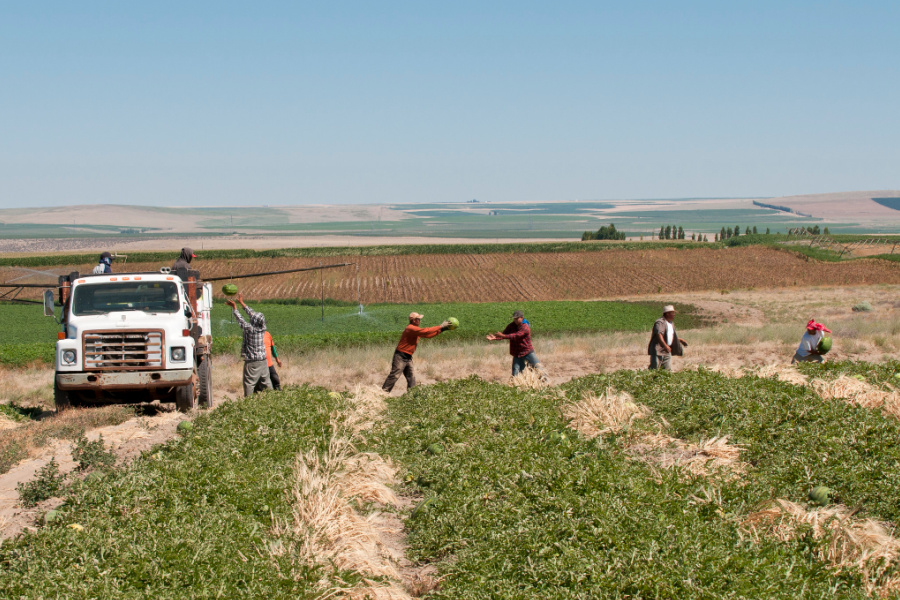Oregon Housing and Community Services interviews show how low wages, housing shortages are impacting farmworkers.
Poverty and lack of housing are pervasive and persistent issues among the more than 100,000 farmworkers who grow, pick, and pack food across the state, says a new study from Oregon Housing and Community Services.
Currently, the average farmworker family in Oregon is making between $20,000 and $25,000 per year, which is 25% to 37% of the median family income for the general population, the study found. Thirty percent of farmworkers in Oregon and Washington experience poverty, compared to 14% of all U.S. households. Estimates show a 3% to 5% decrease in the number of farmworkers in the surveyed counties, while the number of H2-A visa workers, primarily from Mexico, has increased. A lack of affordable housing means farmworker families are often living in poor and overcrowded spaces, the condition of which perpetuates health issues and ongoing poverty.
The goal of the OHCS Agricultural Worker Housing Study was to better understand the challenges facing Oregon farmworkers and their families, and to identify possible solutions. It took four years to complete, as researchers interviewed farmworkers in Hood River, Marion, Morrow and Yamhill counties, with a focus on prioritizing the perspectives of those who are closest to these issues.
The report identified right main issues and made recommendations for increasing wages and available housing for those whose work is critical to Oregon’s food supply.
The most pressing issues facing farmworkers include low wages, an “extreme shortage of good quality housing at prices farmworkers can afford,” poor housing conditions, prohibitive rental application requirements, barriers to home ownership, a lack of resources for finding housing, barriers for employer-provided housing, and a “lack of reliable data about farmworkers and their housing.”
The study notes that not enough data is available on housing options for farmworkers, but they conclude that nearly all farmworker households are cost burdened. Most have unmet housing needs and can not afford housing that is in good condition and not overcrowded
The issue of housing quality is illustrated through farmworker interviews; 96% of respondents report living in overcrowded conditions and 65% in severely overcrowded conditions. Two of the people interviewed said they share a cabin with 20 other people.
Subsidized housing is available through certain organizations, like the Oregon Human Development Corporation, but there isn’t nearly enough. In Hood River, Marion, Morrow, and Yamhill counties there are only 395 subsidized rental units, while 83,731 farmworker families live in those counties. In Marion and Yamhill counties, 455 applicants are on waitlists. The report also found that the cost of some subsidized housing is still out of reach for farmworkers. On top of housing being too expensive, inconsistent income makes it difficult to qualify for housing on many rental applications, and lack of transportation is an issue for living far from work.
COVID-19, wildfires, and a changing climate have all made the housing crisis even worse for farmworkers. One in four reported their housing situation was impacted by the pandemic, whether due to work closures or because they had to take time for illness or quarantine. Wildfires and heat waves impacted housing for one in four farmworkers as well. From lost wages due to poor crop yields or missed harvests to respiratory issues and heat stroke suffered from working during times of dangerous air quality and temperatures, farmworkers and their families are on the front lines of extreme weather.
These housing issues are having negative impacts on the emotional well-being of many farmworkers. Half of the 80 people interviewed reported stress, frustration, anxiety, fear, and “feeling rejected by society,” due to difficulty finding housing.
Employers of farmworkers were also interviewed for the study. Those who provide housing for their employees said it is “a great benefit to their workers,” and it’s often the only housing available. But they also reported major challenges in providing that housing, including cost and OSHA regulations. Most employers mentioned the new OSHA rules on heat and air quality “make it harder for them to provide housing for farmworkers.” These new regulations were adopted in 2022, requiring employers to provide shade and drinking water, increased paid breaks, and training on heat illness prevention plans.
The study concluded with recommendations that could increase available housing, along with ways to fund said housing. Ultimately, more public funding and subsidies are needed for employers and developers to build and maintain housing that is affordable and used seasonally. Other recommendations included portable affordable housing, shared housing between farms, and making low-interest loans available to farmers looking to provide farmworker housing.
When farmworkers were asked what recommendations they would make to those working on solutions, many said government assistance was necessary, but doubted the government would step in to help them.
“To the state and federal [government],” wrote one respondent, “please support in a reform. We are souls in the dark.”







